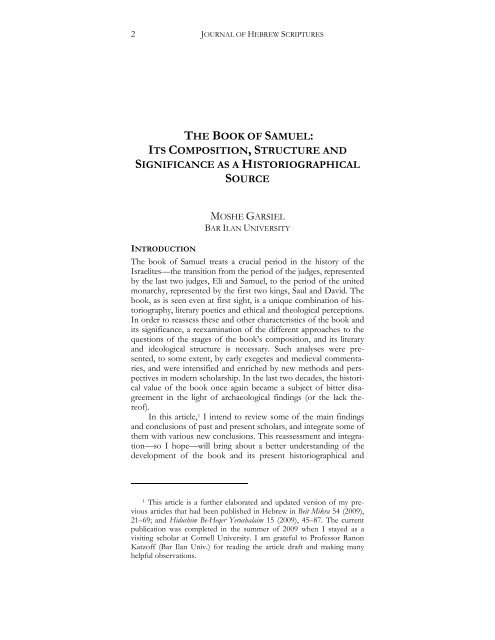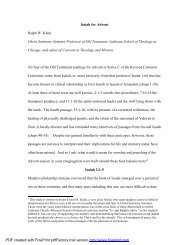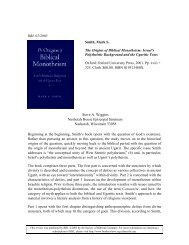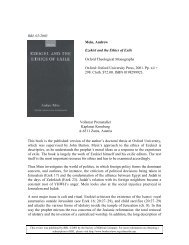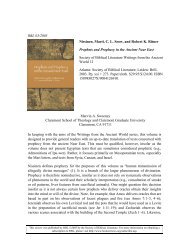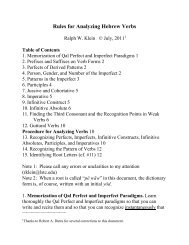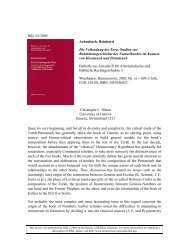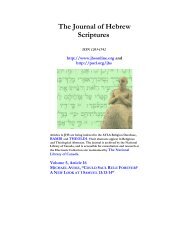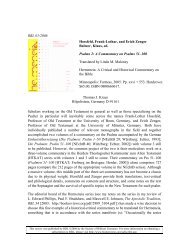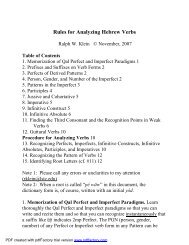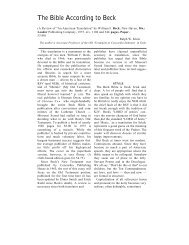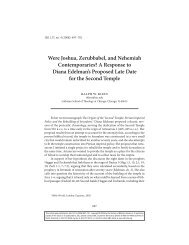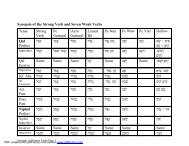The Book of Samuel: Its Composition, Structure and Significance as ...
The Book of Samuel: Its Composition, Structure and Significance as ...
The Book of Samuel: Its Composition, Structure and Significance as ...
Create successful ePaper yourself
Turn your PDF publications into a flip-book with our unique Google optimized e-Paper software.
2 JOURNAL OF HEBREW SCRIPTURES<br />
THE BOOK OF SAMUEL:<br />
ITS COMPOSITION, STRUCTURE AND<br />
SIGNIFICANCE AS A HISTORIOGRAPHICAL<br />
SOURCE<br />
MOSHE GARSIEL<br />
BAR ILAN UNIVERSITY<br />
INTRODUCTION<br />
<strong>The</strong> book <strong>of</strong> <strong>Samuel</strong> treats a crucial period in the history <strong>of</strong> the<br />
Israelites—the transition from the period <strong>of</strong> the judges, represented<br />
by the l<strong>as</strong>t two judges, Eli <strong>and</strong> <strong>Samuel</strong>, to the period <strong>of</strong> the united<br />
monarchy, represented by the first two kings, Saul <strong>and</strong> David. <strong>The</strong><br />
book, <strong>as</strong> is seen even at first sight, is a unique combination <strong>of</strong> historiography,<br />
literary poetics <strong>and</strong> ethical <strong>and</strong> theological perceptions.<br />
In order to re<strong>as</strong>sess these <strong>and</strong> other characteristics <strong>of</strong> the book <strong>and</strong><br />
its significance, a reexamination <strong>of</strong> the different approaches to the<br />
questions <strong>of</strong> the stages <strong>of</strong> the book’s composition, <strong>and</strong> its literary<br />
<strong>and</strong> ideological structure is necessary. Such analyses were presented,<br />
to some extent, by early exegetes <strong>and</strong> medieval commentaries,<br />
<strong>and</strong> were intensified <strong>and</strong> enriched by new methods <strong>and</strong> perspectives<br />
in modern scholarship. In the l<strong>as</strong>t two decades, the historical<br />
value <strong>of</strong> the book once again became a subject <strong>of</strong> bitter disagreement<br />
in the light <strong>of</strong> archaeological findings (or the lack there<strong>of</strong>).<br />
In this article, 1 I intend to review some <strong>of</strong> the main findings<br />
<strong>and</strong> conclusions <strong>of</strong> p<strong>as</strong>t <strong>and</strong> present scholars, <strong>and</strong> integrate some <strong>of</strong><br />
them with various new conclusions. This re<strong>as</strong>sessment <strong>and</strong> integration—so<br />
I hope—will bring about a better underst<strong>and</strong>ing <strong>of</strong> the<br />
development <strong>of</strong> the book <strong>and</strong> its present historiographical <strong>and</strong><br />
1 This article is a further elaborated <strong>and</strong> updated version <strong>of</strong> my previous<br />
articles that had been published in Hebrew in Beit Mikra 54 (2009),<br />
21–69; <strong>and</strong> Hidushim Be-Heqer Yerushalaim 15 (2009), 45–87. <strong>The</strong> current<br />
publication w<strong>as</strong> completed in the summer <strong>of</strong> 2009 when I stayed <strong>as</strong> a<br />
visiting scholar at Cornell University. I am grateful to Pr<strong>of</strong>essor Ranon<br />
Katz<strong>of</strong>f (Bar Ilan Univ.) for reading the article draft <strong>and</strong> making many<br />
helpful observations.


